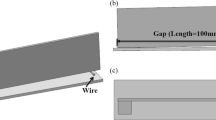Abstract
In this paper, we describe experimental torch welding 1061 aluminum alloy to T2 copper. The corrosion behavior and performance of Cu/Al brazed joints were systematically investigated. This investigation was conducted using an optical microscope (OM), scanning electron microscope (SEM), energy disperse spectroscopy (EDS) and other methodologies. The results showed that the corrosion resistance of brazed joints was closely associated with Al content in filler metal. The corrosion behavior in 3.5 % NaCI solution belonged to micro-electrochemical corrosion and depended mainly on electrochemical imbalance between different phases. The excessive dissolution of Al atoms led to the occurrence of the corrosion of brazed joints and the corrosion product may be Al(OH)3, Zn(OH)2 and ZnO. It can be also found that an increase of aluminum content controlled largely formation and distribution of α-Al phase and Al2O3 protective film in brazing alloys, resulting in reducing the electrochemical corrosion current density and improving the corrosion resistance and shear strength of the joint.
Similar content being viewed by others
References
L. Zhou, G. H. Li, R. X. Zhang and W. L. Zhou, Microstructure evolution and mechanical properties of friction stir spot welded dissimilar aluminum-copper joint, Journal of Alloys and Compounds, 775 (2019) 372–382.
Y. Xiao, M. Li and L. Wang, Interfacial reaction behavior and mechanical properties of ultrasonically brazed Cu/Zn-Al/Cu joints, Materials and Design, 73 (2015) 42–49.
H. Yang, J. Huang, S. H. Chen, X. Zhao, Q. Wang and D. Li, Influence of the composition of Zn-Al filler metal on the interfacial structure and property of Cu/Zn-Al/Al brazed joint, Acta Metallurgica Sinica, 51 (3) (2015) 364–370.
Z. W. Niu, Z. Ye and J. H. Huang, Interfacial structure and properties of Cu/Al joints brazed with Zn-Al filler metals, Materials Characterization, 138 (2018) 78–88.
S. T. Ma, Y. F. Yan and H. N. Wang, Impact of Cu content on corrosion property of Zn20Sn lead-free solder, Transactions of the China Welding Institution, 37 (2016) 75–79.
X. G. Wang, X. G. Li and C. G. Wang, Influence of diffusion brazing parameters on microstructure and properties of Cu/Al joints, Journal of Manufacturing Processes, 35 (2018) 343–350.
H. W. Zhang, W. Cui, J. S. He, J. C. Yan and S. Q. Yang, Formation and evolution of intermetallic compounds at interfaces of Cu/Al joints by ultrasonic-assisted soldering, Journal of Materials Processing Technology, 223 (2015) 1–7.
Z. Z. Yin and F. L. Sun, Corrosion mechanism analysis of copper and aluminum brazed joints, Transactions of the China Welding Institution, 38 (10) (2017) 121–124.
Y. Q. Wang, G. Kong and C. S. Che, Corrosion behavior of Zn-Al alloys in saturated Ca(OH)2 solution, Corrosion Science, 112 (11) (2016) 679–686.
M. S. Azevedo, C. Allely and K. Ogle, Corrosion mechanisms of Zn (Mg, Al) coated steel: 2. The effect of Mg and Al alloying on the formation and properties of corrosion products in different electrolytes, Corrosion Science, 90 (1) (2015) 482–490.
S. Huang, W. M. Long and Q. B. Lu, Research on the corrosion resistance of Cu-Al joints brazed with flux-cored Zn-2Al filler metal, Materials Research Express, 6 (2019) 1–9.
L. J. Yang, X. D. Zeng and Y. M. Zhang, Evolution of atmospheric corrosion of superplastic Zn-Al alloys exposed to an industrial environment, Materials and Corrosion, 66 (10) (2015) 1169–1180.
F. Long, Q. X. Hu and Z. X. Zhang, Corrosion resistance of 1060 aluminum brazed seam, Transactions of the China Welding Institution, 36 (7) (2015) 30–34.
Y. Zheng, H. Yang and J. H. Huang, A novel Zn-Al-Si corrosion resistant filler metal for Cu/Al brazing, Materials Letters, 206 (2017) 201–204.
Acknowledgments
This work was supported by the State Key Laboratory of Advanced Brazing Filler Metals and Technology. It was also funded by the International S&T Cooperation Program of China (Grant No. 2016YFE0201300) and the National program for leading scientific and technological innovation talents program (Grant No. 2032X2018004).
Author information
Authors and Affiliations
Corresponding author
Additional information
Recommended by Editor Chongdu Cho
Junlan Huang received her Master’s degree in Zhengzhou Research Institute of Mechanical Engineering Co., Ltd., China in 2010. She is a Senior Engineer in the State Key Laboratory of Advanced Brazing Filler Metals and Technology, Zhengzhou, China. Her research is focused on the brazing dissimilar metals of copper and aluminum.
Rights and permissions
About this article
Cite this article
Huang, J., Long, W. & Zhong, S. Effect of Al element in Zn-Al fillers on the corrosion resistance of Cu/Al brazed joints. J Mech Sci Technol 34, 711–717 (2020). https://doi.org/10.1007/s12206-020-0117-4
Received:
Revised:
Accepted:
Published:
Issue Date:
DOI: https://doi.org/10.1007/s12206-020-0117-4




